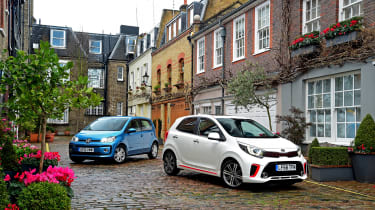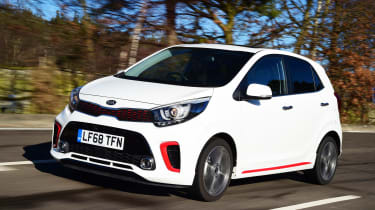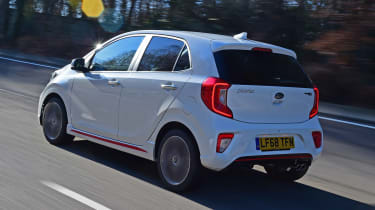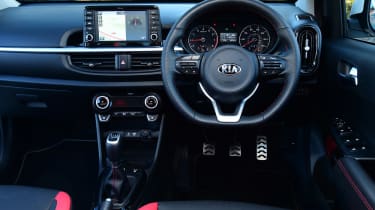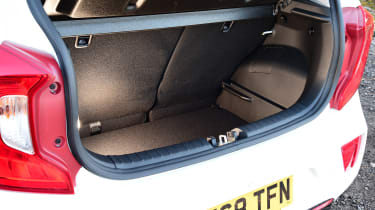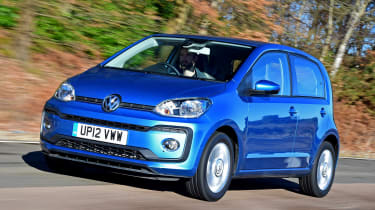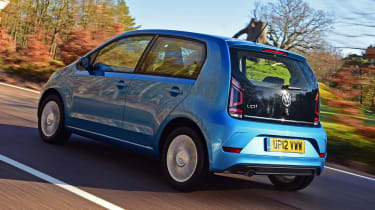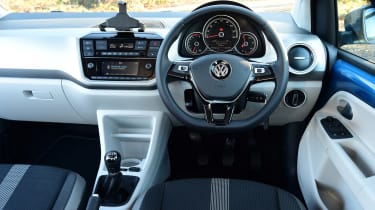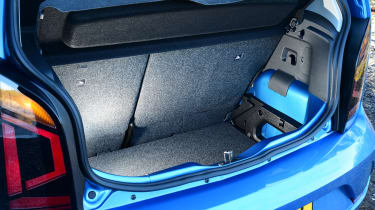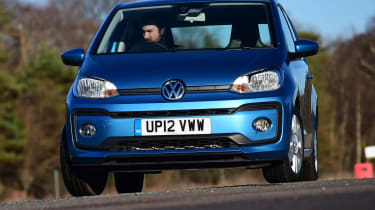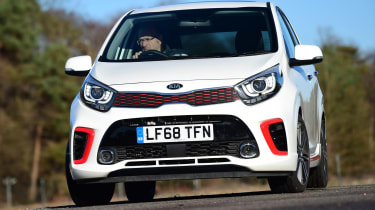Kia Picanto vs Volkswagen up!
The Kia Picanto finally gets a turbocharger, and we pitch it against the Volkswagen up! in our city car challenge
The latest Kia Picanto has been jostling for position with the city car class leaders since it was launched in 2017, thanks to its wide appeal at a wallet-friendly price. It uses the same formula as all its leading rivals, with a grown-up driving experience, low running costs and a surprisingly spacious interior.
One thing it was missing, until now, was a turbo engine at the top of the range. The turbocharged Volkswagen up! has long been a favourite of ours, because it brings an even more mature driving experience and adds plenty of fun, too.
Here we’re taking a closer look at Kia’s new 1.0-litre T-GDi turbo petrol motor, which aims to combine efficiency with a bit more performance and flexibility. We’re testing the Picanto in GT-Line S trim, which is a bit more expensive than this High up! model, but if you look at the pair’s price as tested, you’ll notice that they’re much closer overall. So which of these tiny turbo city cars is the better choice? Read on to find out.
Kia Picanto
| Model: | Kia Picanto 1.0 T-GDi GT-Line S |
| Price: | £14,720 |
| Engine: | 1.0-litre 3cyl petrol, 99bhp |
| 0-60mph: | 9.1 seconds |
| Test economy: | 47.1mpg/10.4mpl |
| CO2: | 117g/km |
| Annual road tax: | £140 |
The latest Kia Picanto is more grown-up than ever, and this GT-Line S model sits at the top of the range with the new 1.0-litre turbo petrol engine. It’s £14,720 list price puts it at the expensive end of the city car market, but match its spec with options on the VW up! and the cars cost a similar amount.
Design & engineering
Previously the Picanto was available with a 66bhp 1.0-litre engine or an 83bhp 1.25-litre unit, but this new turbo version boosts power to an impressive 99bhp. It’s manual only in this form, although a four-speed automatic box can be specced on the 1.25-litre model.
More reviews
Car group tests
- Hyundai i10 vs Kia Picanto: 2022 twin test review
- Hyundai i10 vs Toyota Aygo vs Kia Picanto
- 3. Kia Picanto - Best city cars
- Toyota Aygo vs Kia Picanto
- Kia Picanto: £99 per month
In-depth reviews
Road tests
Used car tests
The Kia matches the VW’s suspension layout, using MacPherson-strut front suspension and a torsion beam at the rear. The up! is slightly smaller, with a shorter wheelbase, too, yet the brand has used clever packaging to maximise space inside.
Some components in the Picanto are shared with the Hyundai i10, just as the VW has its own sister cars (the SEAT Mii and Skoda Citigo) to help with economies of scale and keep prices more affordable.
In GT-Line S spec, the Picanto features 16-inch alloy wheels, sportier bumpers, tinted windows, LED daytime running lights and a chrome grille surround, which give it a sportier look than the up!.
On the inside there are artificial leather seats and sporty-looking pedals as well. The main difference between the two cars in the cabin is that the Kia features a seven-inch touchscreen display with satellite navigation, smartphone connectivity and connected services, while in the up! there’s simply a mount for your phone.
Quality can’t match that of the VW, because some of the cost-saving materials present in both models are hidden away in the German car, but on show in the Picanto. Still, build quality is on par; these two products are prime examples of city cars that feel more grown-up than you might expect them to.
Driving
That maturity extends to the driving experience, too, because the Kia is quite refined, even though it can’t quite match the up! here. The engine is very quiet at idle, but wind and road noise are much more noticeable when you’re up to speed than in the VW.
However, the difference gets smaller the faster you go, and on the motorway there’s not too much in it. Both competitors are good for a city car, but you’ll still need to turn up the volume on the audio system to drown out the outside world at speed.
The Kia rides well most of the time, and it’s smooth enough around town, but it’s not as composed as the Volkswagen. Big potholes cause more of a stir in the Picanto’s cabin, for example.
The steering isn’t quite as direct as in the up! – although it is a bit heavier – while the gearshift isn’t as slick, either. Still, it’s fun to use, with a light clutch and a neat, mechanical feel.
It means you can make the most of the engine, which is a real highlight. This new turbocharged motor is undoubtedly the best part about the driving experience; the extra power and torque ensure this version of the Picanto is brilliant fun. We recorded a 0-60mph time of 9.1 seconds at our test track – 0.9 seconds faster than its rival – and the Kia was also significantly quicker in our in-gear tests.
It’s a little more powerful than the up!, but from behind the wheel there’s a distinct difference between them; overtaking opportunities are more limited in the VW, for example, because you’ll have to find a longer section of road to get past slower traffic.
This strong performance, combined with the Kia’s lighter body and satisfying controls, means that while this is no hot hatch, the 1.0 T-GDi Picanto is up with the 365bhp Stinger GT-S as one of the most enjoyable drivers’ cars that the brand makes.
Practicality
The Picanto has the advantage when it comes to pure boot space, although it’s not by much. There are 255 litres with the rear seats in place, four more than the VW, but it’s also the more spacious choice with them folded. You get 1,010 litres in total, while the up! has 959 litres.
As with the up!, there’s a large loading lip and the seats don’t fold down completely flat. Still, both cars have a moveable boot floor that can be raised to create a flatter surface.
The trade-off for the extra boot space in the Picanto comes with rear legroom, because there’s much less space here than in the up!. Headroom is good in both cars, although there’s a lot more space in the back of the Volkswagen.
Ownership
A seven-year warranty comes as standard with every Kia, and the brand did quite well in our Driver Power 2018 satisfaction survey, although its eighth-place finish was behind Volkswagen’s fifth out of 26 makers.
The Picanto gained a four-star Euro NCAP crash rating under tougher requirements in 2017, but has better safety kit. For a start, there are six airbags to the VW’s four, and the Kia has autonomous braking fitted as standard (it’s a £380 option on the up!).
Running costs
In our hands, the Picanto was the more economical car, returning 47.1mpg and costing £1,378 a year to fuel. We got 43.3mpg from the VW, which will cost £1,499 a year to run.
But the higher list price and lower predicted residual values mean the Kia will lose more after a typical three-year ownership. It only keeps 38.6 per cent of its value in that time, so the Kia will be worth £5,675 and lose £9,045. A 40.9 per cent figure means the up! loses only £7,896, but it will be worth slightly less (£5,464).
Testers’ notes: “Many city car buyers will choose PCP, so this has a big bearing on running costs. The Picanto will set you back £2,196 more over 36 months, which would pay for tax, insurance and servicing.”
Volkswagen up!
| Model: | Volkswagen High up! 1.0 90 5dr |
| Price: | £13,360 |
| Engine: | 1.0-litre 3cyl petrol, 89bhp |
| 0-60mph: | 10.0 seconds |
| Test economy: | 43.3mpg/9.5mpl |
| CO2: | 96g/km |
| Annual road tax: | £140 |
The Volkswagen up! is the only version of the VW Group’s city car siblings that features a turbocharged petrol engine in its range. Here we’re testing the top-spec High up! model in five-door form to match its range-topping Picanto rival, although at £13,360, it’s a bit cheaper than the Kia.
Design &engineering
Beneath the skin of the up! is the same chassis that underpinned the original car and its Skoda Citigo and SEAT Mii cousins at launch in 2012. All three use the VW Group’s NSF (New Small Family) platform, which has MacPherson struts and a torsion-beam rear axle, like the Kia.
The Volkswagen’s engine has 10bhp less than the Picanto here, at 89bhp, but the cars are otherwise very similar in design, with a five-speed manual transmission and five-door body style.
A three-door up! is available, saving £400, but that’s a small price to pay for the extra practicality of the additional doors. Sadly, the back windows are pop-out only, but you get electric windows in the Kia.
The rest of the interior is impressive, though. The cloth seats are comfortable and compare well with the artificial leather in the Kia, while the dashboard looks more upmarket, too, thanks to its cleaner design. Key touch points, such as the steering wheel and gearlever, also feel slightly more premium.
But this top-spec up! isn’t as well equipped as its competitor. It does without a touchscreen display completely, instead featuring a USB port and a holder for a smartphone. For most buyers that will be fine, but it means there’s no sat-nav for those people without a compatible phone.
The High up! does get 15-inch alloy wheels, heated front seats, Bluetooth and DAB radio, but it’s missing several items that are standard on the Kia; AEB, a reversing camera and cruise control are all optional. But then it’s cheaper and even after adding these features it still costs less.
Driving
The driving experience has always been the VW’s strong point and it feels like a very polished product.
Both the steering and gearshift are precise and light, while there’s plenty of grip, so it’s great fun whether you’re heading down a country road or just nipping to the shops. The ride is good for a small car and the up! deals with potholes better than its rival.
The suspension set-up is comfortable and only the wind and road noise are a hint that this is still a cheap car, because otherwise you might mistake the VW for a more expensive model from behind the wheel. It’s quieter than the Picanto and thanks to the turbo torque, refinement and decent tech, like the Kia, we wouldn’t shy away from a long journey in the up!.
The thrummy three-cylinder engine is another highlight, because it provides punchy performance and combines that with an entertaining soundtrack.
But at our test track the VW trailed the Kia. The 0-60mph sprint took 10 seconds, which was 0.9 seconds behind the Picanto, and the up! was slower from 30-70mph through the gears as well; it posted a time of 10.8 seconds to the Kia’s 9.6 seconds. The Volkswagen took 13.4 seconds to go from 50-70mph in fifth gear, while the Kia needed 10.3 seconds, which means the Picanto is more at home on the motorway, although the up! is a better car to cruise in than its South Korean competitor.
The up! is also great fun, though, helped by its light but precise steering, solid body control and sense of youthfulness.
Practicality
At 251 litres, the Volkswagen’s boot is slightly smaller than its rival’s, but neither car is really spacious when it comes to luggage capacity. A total of 959 litres with the rear seats folded down is helpful, although it still trails the Picanto here as well.
The amount of space in the cabin is the VW’s strong point, because adults can easily fit in each of the four seats; headroom and legroom are both better than in the Kia. It feels lighter and more spacious inside, too, thanks to the design of the dashboard and the larger window area.
However, there’s less in-cabin storage in the German hatch, because the Kia features larger cup-holders and a bigger front cubby, plus storage space by the handbrake that’s missing in the VW.
Ownership
Volkswagen came in fifth overall in our Driver Power 2018 satisfaction survey, which is a strong result. But its dealers have some way to go; they finished 18th, while Kia’s were seventh out of 28 marques. The VW also comes with a three-year warranty, a lot less than the seven-year package offered with the Kia.
Euro NCAP awarded the up! a five-star rating in 2012, but it’s missing AEB next to the Kia here (it’s £380) and has two fewer airbags. A reversing camera is £240 and parking sensors are £300 as part of the Cruise and Park Pack. All are standard on the Kia.
Running costs
Insurance will be a key consideration for many city car buyers, but for our example driver there is little difference between these models, which both sit in group 10: the Volkswagen costs £361, the Kia £364 a year.
Still, for company car drivers, lower CO2 emissions of 96g/km mean the up! sits in the 20 per cent Benefit-in-Kind (BiK) bracket, so lower-rate earners will pay £527 a year in company car tax with the Volkswagen.
The Picanto costs £696 a year, yet offers more standard kit. This offsets the VW’s higher fuel bills, based on our average test economy on test.
Verdict
First place: Volkswagen up!
The VW up! nudges ahead of its rival in this photo finish result due to its lower price. It’s also more comfortable and more spacious inside than the Picanto, and great fun to drive as well. Yet the up! is let down by a lack of equipment, particularly infotainment. If this is a priority, the Kia will be a better buy, but the VW fits more buyers’ needs more of the time.
Second place: Kia Picanto
All that stands between this turbo version of the Picanto and a road test win against the up! is its higher price and running costs. It features a potent and really enjoyable engine and it’s great fun to drive. The Kia is also loaded with standard kit, is more economical and has a bigger boot. It’s just a shame that it’s pricey on PCP finance and isn’t as comfortable or as spacious inside as the Volkswagen.
Is it worth waiting for this model?
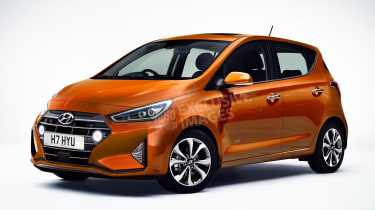
Hyundai i10
Due: 2020Price: From £10kEngine: 1.0-litre 3cyl
Hyundai is planning a revamped i10, previewed in our exclusive image, and it’s set to arrive next year. Expect updated infotainment and more efficient engines, although there’s no news on a turbocharged motor – yet.
Figures
| Volkswagen High up! 1.0 90 5dr | Kia Picanto 1.0 T-GDi GT-Line S | |
| On the road price/total as tested | £13,360/£14,605 | £14,720/£14,935 |
| Residual value (after 3yrs/36,000) | £5,464/40.9% | £5,675/38.6% |
| Depreciation | £7,896 | £9,045 |
| Annual tax liability std/higher rate | £527/£1,054 | £696/£1,392 |
| Annual fuel cost (12k/20k miles) | £1,499/£2,499 | £1,378/£2,297 |
| Insurance group/quote/road tax cost | 10/£361/£140 | 10/£364/£140 |
| Servicing costs | £297 (2 years) | £399 (3 years) |
| Length/wheelbase | 3,600/2,417mm | 3,595/2,400mm |
| Height/width | 1,492/1,645mm | 1,485/1,595mm |
| Engine | 3cyl in-line/999cc | 3cyl in-line/998cc |
| Peak power/revs | 89/5,000 bhp/rpm | 99/4,500 bhp/rpm |
| Peak torque/revs | 160/1,500 Nm/rpm | 171/1,500 Nm/rpm |
| Transmission | 5-speed man/fwd | 5-speed man/fwd |
| Fuel tank capacity/spare wheel | 35 litres/repair kit | 35 litres/repair kit |
| Boot capacity (seats up/down) | 251/959 litres | 255/1,010 litres |
| Kerbweight/payload | 1,002/358kg | 1,020/385kg |
| Turning circle | 9.8 metres | 9.6 metres |
| Basic warranty (miles)/recovery | 3yrs (60,000)/1yr | 7yrs (100,000)/1yr |
| Driver Power manufacturer/dealer pos. | 5th/18th | 8th/7th |
| NCAP: Adult/child/ped./assist/stars | 89/80/46/86/5 (2011) | 87/64/54/47/4 (2017) |
| 0-60/30-70mph | 10.0/10.8 secs | 9.1/9.6 secs |
| 30-50mph in 3rd/4th | 4.9/7.8 secs | 4.7/6.3 secs |
| 50-70mph in 5th | 13.4 secs | 10.3 secs |
| Top speed/rpm at 70mph | 115mph/2,500rpm | 112mph/2,500rpm |
| Braking 70-0/60-0/30-0mph | 51.1/38.2/9.0m | 49.5/35.2/9.1m |
| Noise outside/idle/30/70mph | 71/49/66/75dB | 71/45/71/75dB |
| Auto Express econ (mpg/mpl)/range | 43.3/9.5/333 miles | 47.1/10.4/363 miles |
| WLTP fuel consumption (med) | 55.4mpg | 48.7mpg |
| WLTP fuel consumption (med) | 12.2mpl | 10.7mpl |
| Actual/claimed CO2/tax bracket | 151/96g/km/20% | 139/117g/km/24% |
| Airbags/Isofix/parking sensors/cam | Four/yes/£300*/£240 | Six/yes/yes/yes |
| Auto box/lane-keep/blind spot/AEB | No/no/no/£380 | No/no/no/yes |
| Clim/cruise ctrl/leather/heated seats | £265/£300*/no/yes | Yes/yes/faux/yes |
| Met paint/LEDs/keyless/pwr tailgate | £525/no/no/no | £515/no/yes/no |
| Nav/digi dash/DAB/connected apps | No/no/yes/yes | Yes/no/yes/yes |
| Wireless charge/CarPlay/Android Auto | No/no/no | Yes/yes/yes |
